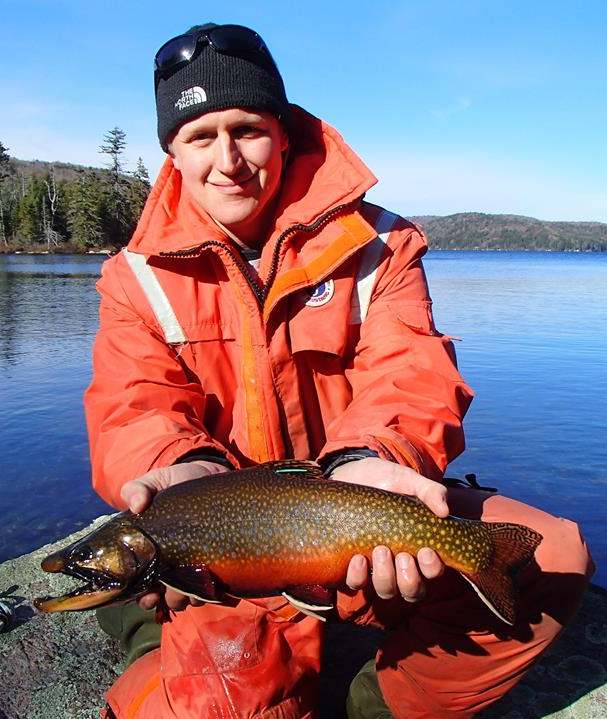About me

I’m a Postdoctoral Associate studying freshwater ecology in the Marsden Lab at the University of Vermont's Rubenstein Ecosystem Science Laboratory. My research focuses on the use of quantitative methods and population genetics to assess restoration of lake trout in Lake Champlain. In my free time, I’m also a hiker, skier, beekeeper, and occasional dabbler in electronic design.
Prior to working at UVM, I earned my M.S. and Ph.D. from Cornell University where I studied fisheries population dynamics in response to anthropogenic disturbances as part of the Adirondack Fishery Research Program.
Current projects
Assessing wild lake trout recruitment using close-kin mark-recapture
Effective fisheries management and restoration requires reliable estimates of abundance and population trajectories through time. However, absolute population estimates are extremely difficult to obtain in large systems due to the prohibitively high sample sizes required by most approaches. Close-kin mark-recapture (CKMR) is a new technique that can obviate this hurdle by using the observed kinship within a sample to estimate the true adult abundance. We are developing a CKMR model for lake trout (Salvelinus namaycush) in Lake Champlain in order to evaluate the size of the parental population contributing to the recently-observed (and much celebrated) wild recruitment. In addition to providing information for managing Champlain’s population, the resulting analysis pipeline will be designed with enough flexibility for application to other systems and species. For a better understanding of CKMR study design, take a look at this calculator (still very much in beta).
Lake trout stocking performance in Lake Champlain
Despite evidence of sustained wild recruitment, Lake Champlain’s lake trout population in still primarily a stocked fishery. While the drivers behind the recent recruitment success are unknown, shifts favoring the survival of wild fish could similarly affect stocked juveniles, suggesting that the current stocking strategies may produce different results than they have in the past. Until 2022, Champlain was stocked with ~82,000 fish annually that came from either New York (33% of total, “Seneca strain” fish stocked at age-1 in the spring) or Vermont (66% of total, “Champlain strain” fish stocked at age-0 in the fall). With the onset of wild recruitment this stocking has been adjusted downwards by eliminating the New York portion. However, the relative survival and performance of the two stocking components are unknown. We designed a sequencing-based genetic marker panel to identify the origin of stocked fish in the lake. In combination with an archived tissue samples from 2000+ fish and maxillary aging, we are conducting a mixed-stock analysis in order to inform future stocking adjustments.
Burbot population structure using low-coverage whole-genome sequencing
Burbot (Lota lota) is the only freshwater cod and inhabits cold lakes and rivers throughout the northern hemisphere. The species is likely an important component of the food web in many systems, but little is known about the current status of most populations. Because burbot require cool (<25°C) water and are not especially mobile they are especially vulnerable to habitat fragmentation and climate change. In Lake Champlain, there is concern that the construction of several causeways in the 1800s has isolated fish between the five main basins, potentially splitting the population into several parts. We are investigating this dynamic using low-coverage whole-genome sequencing to evaluate population structure and estimate the contemporary effective population size.
Publications
Hemmelgarn, G.L., Marcy-Quay, B., Marsden, J.E. (2022). Contemporary growth and survival of stocked and wild lake trout in Lake Champlain evaluated using maxillary age estimates. North American Journal of Fisheries Management.
Marsden, J.E., Schumacher, M.N., Wilkins, P.D., Marcy-Quay, B., Alger, B. Rokosz, K. Kozel, C.L. (2022). Diet differences between stocked and wild age-0 to age-3 lake trout indicate influence of early rearing environments. Journal of Great Lakes Research. 48(3), 782-789.
Marcy-Quay, B., Kraft, C.E.(2021). Diel movement by white suckers (Catostomus commersonii) in connected northern lakes. Northeastern Naturalist. 28(4), 430-443.
Marsden, J.E., Marcy-Quay, B. (2020). A generalized model for correcting bias due to permeability using emergent fry traps in mesocosm experiments. Fisheries Research. 233:105769.
Marcy-Quay, B., Sethi, S. A., Therkildsen, N. O., and Kraft, C. E. (2020). Expanding the feasibility of fish and wildlife assessments with close-kin mark–recapture. Ecosphere, 11:03259.
Andres, K., Sethi, S., Duskey, E., Lepak, J., Rice, A., Estabrook, B., Fitzpatrick, K., George, E., Marcy-Quay, B., Paufve, M., Perkins, K., and Scofield, A. (2020). Seasonal habitat use indicates depth may mediate the potential for trophic impacts of invasive round goby in inland lakes. Freshwater Biology. 65(5), 1-11.
Marcy-Quay, B., Jirka, K.J. and Kraft, C.E. (2019). Time versus space: choice of effort metric can avoid bias in boat electrofishing CPUE. North American Journal of Fisheries Management. 39(6), 1207-1216.
Bemis, K. E., Marcy-Quay, B., Galbraith, J. K., Wuenschel, M. J., Sullivan, P. J., and Bemis, W. E. (2018). Deep-Water Dragonets (Teleostei: Callionymidae: Foetorepus) of the Mid Atlantic Bight: A Little-Known Genus from the Edge of the Continental Shelf. Copeia, 106(1), 188-198.
Alexiades, A.V., Marcy-Quay, B., P.J. Sullivan, and Kraft, C. E. (2014). Measurement error in angler creel surveys. North American Journal of Fisheries Management. 35(2), 253–261.